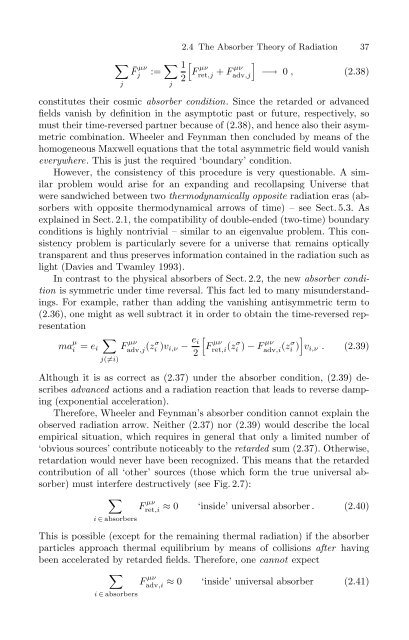The Physical Basis of The Direction of Time (The Frontiers ...
The Physical Basis of The Direction of Time (The Frontiers ...
The Physical Basis of The Direction of Time (The Frontiers ...
Create successful ePaper yourself
Turn your PDF publications into a flip-book with our unique Google optimized e-Paper software.
∑<br />
j<br />
¯F µν<br />
j<br />
:= ∑ j<br />
2.4 <strong>The</strong> Absorber <strong>The</strong>ory <strong>of</strong> Radiation 37<br />
1<br />
[<br />
]<br />
F µν<br />
ret,j<br />
2<br />
+ F µν<br />
adv,j<br />
−→ 0 , (2.38)<br />
constitutes their cosmic absorber condition. Since the retarded or advanced<br />
fields vanish by definition in the asymptotic past or future, respectively, so<br />
must their time-reversed partner because <strong>of</strong> (2.38), and hence also their asymmetric<br />
combination. Wheeler and Feynman then concluded by means <strong>of</strong> the<br />
homogeneous Maxwell equations that the total asymmetric field would vanish<br />
everywhere. This is just the required ‘boundary’ condition.<br />
However, the consistency <strong>of</strong> this procedure is very questionable. A similar<br />
problem would arise for an expanding and recollapsing Universe that<br />
were sandwiched between two thermodynamically opposite radiation eras (absorbers<br />
with opposite thermodynamical arrows <strong>of</strong> time) – see Sect. 5.3. As<br />
explained in Sect. 2.1, the compatibility <strong>of</strong> double-ended (two-time) boundary<br />
conditions is highly nontrivial – similar to an eigenvalue problem. This consistency<br />
problem is particularly severe for a universe that remains optically<br />
transparent and thus preserves information contained in the radiation such as<br />
light (Davies and Twamley 1993).<br />
In contrast to the physical absorbers <strong>of</strong> Sect. 2.2, the new absorber condition<br />
is symmetric under time reversal. This fact led to many misunderstandings.<br />
For example, rather than adding the vanishing antisymmetric term to<br />
(2.36), one might as well subtract it in order to obtain the time-reversed representation<br />
ma µ i = e ∑<br />
i F µν<br />
adv,j (zσ i )v i,ν − e [<br />
]<br />
i<br />
F µν<br />
ret,i<br />
2<br />
(zσ i ) − F µν<br />
adv,i (zσ i ) v i,ν . (2.39)<br />
j(≠i)<br />
Although it is as correct as (2.37) under the absorber condition, (2.39) describes<br />
advanced actions and a radiation reaction that leads to reverse damping<br />
(exponential acceleration).<br />
<strong>The</strong>refore, Wheeler and Feynman’s absorber condition cannot explain the<br />
observed radiation arrow. Neither (2.37) nor (2.39) would describe the local<br />
empirical situation, which requires in general that only a limited number <strong>of</strong><br />
‘obvious sources’ contribute noticeably to the retarded sum (2.37). Otherwise,<br />
retardation would never have been recognized. This means that the retarded<br />
contribution <strong>of</strong> all ‘other’ sources (those which form the true universal absorber)<br />
must interfere destructively (see Fig. 2.7):<br />
∑<br />
F µν<br />
ret,i ≈ 0 ‘inside’ universal absorber . (2.40)<br />
i ∈ absorbers<br />
This is possible (except for the remaining thermal radiation) if the absorber<br />
particles approach thermal equilibrium by means <strong>of</strong> collisions after having<br />
been accelerated by retarded fields. <strong>The</strong>refore, one cannot expect<br />
∑<br />
F µν<br />
adv,i<br />
≈ 0 ‘inside’ universal absorber (2.41)<br />
i ∈ absorbers



![arXiv:1001.0993v1 [hep-ph] 6 Jan 2010](https://img.yumpu.com/51282177/1/190x245/arxiv10010993v1-hep-ph-6-jan-2010.jpg?quality=85)


![arXiv:1008.3907v2 [astro-ph.CO] 1 Nov 2011](https://img.yumpu.com/48909562/1/190x245/arxiv10083907v2-astro-phco-1-nov-2011.jpg?quality=85)








![arXiv:1002.4928v1 [gr-qc] 26 Feb 2010](https://img.yumpu.com/41209516/1/190x245/arxiv10024928v1-gr-qc-26-feb-2010.jpg?quality=85)
![arXiv:1206.2653v1 [astro-ph.CO] 12 Jun 2012](https://img.yumpu.com/39510078/1/190x245/arxiv12062653v1-astro-phco-12-jun-2012.jpg?quality=85)
